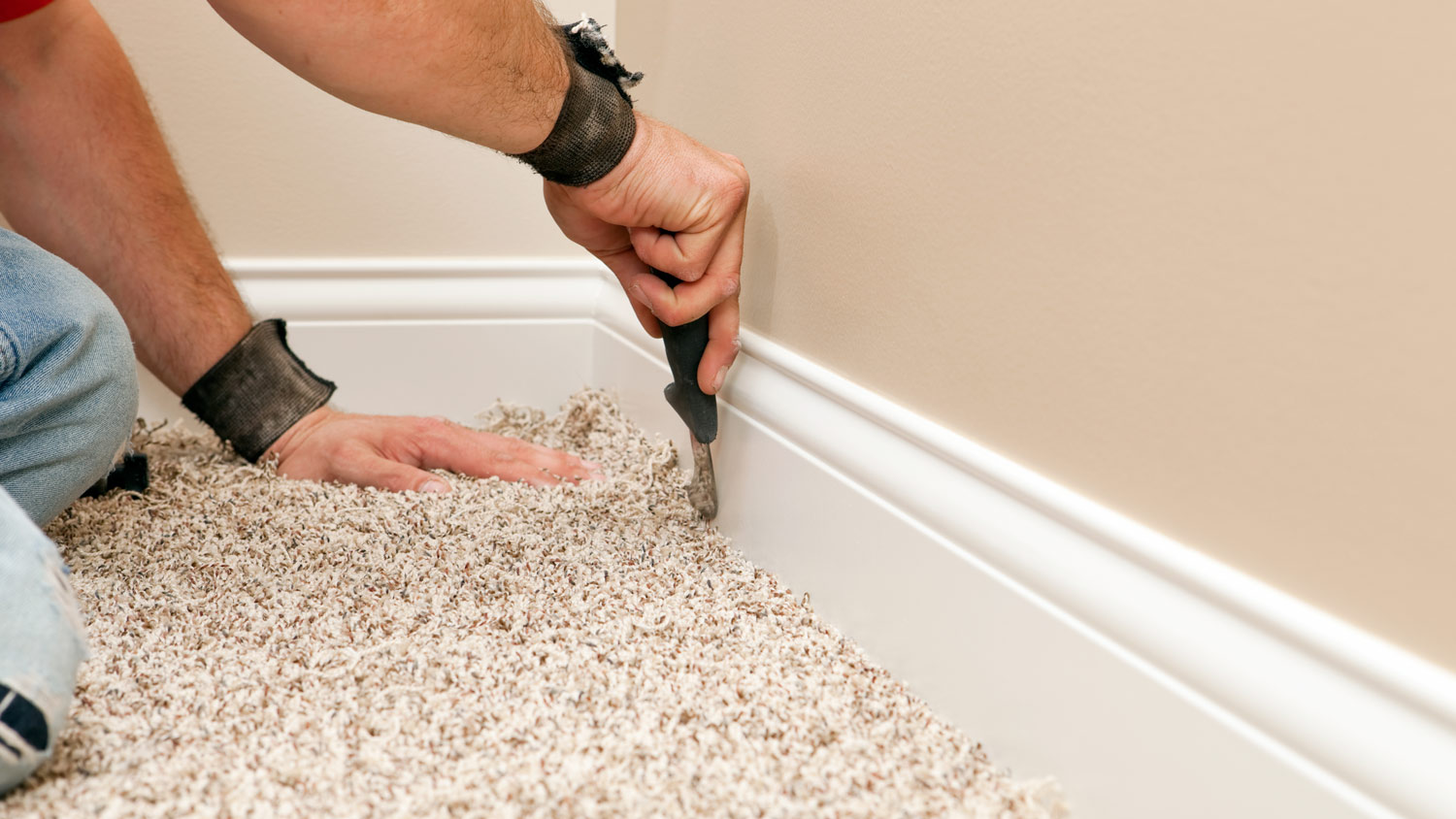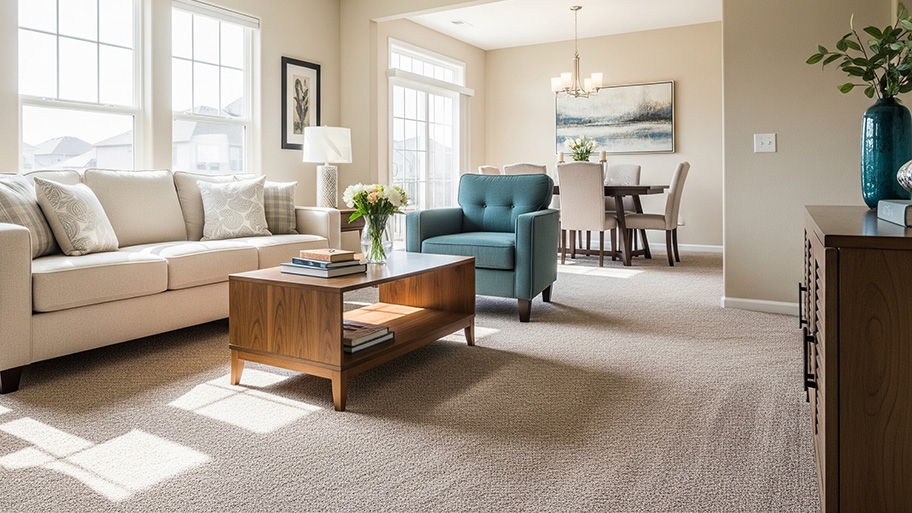
Carpet padding makes your carpet feel extra comfortable and protects your floors from damage, but how much does carpet padding cost? Let’s look at the numbers.
The average carpet repair cost ranges from $140 to $400, with most homeowners paying around $250. Main cost factors include repair type, carpet material, and labor rates.


The type of carpet, such as plush or Berber, affects overall repair costs.
Small repairs may be priced per square foot, while larger repairs are often charged per room.
Labor can be charged hourly, per square foot, or per project, averaging $40 to $80 per hour.
Add-ons increase project costs, including padding replacement, subfloor repair, and odor removal.
This article was created using automation technology and thoroughly fact-checked and edited by an Angi Editor in accordance with our AI policy.
Carpet repair cost is a key concern for homeowners facing stains, tears, or wrinkles in their flooring. Most carpet repairs cost between $140 to $400, with an average of $250 per project. Expect to pay $1.50 to $3.50 per square foot for common repairs, depending on the type and extent of damage.
Repairing carpet helps restore comfort, safety, and appearance in your home. This guide explains what influences your carpet repair cost, compares repair methods, and shares tips to help you make the best decision for your floors.
Several key factors influence your carpet repair cost. Understanding these helps you plan your budget and avoid surprises.
The type of repair your carpet needs has a major effect on overall cost. Common repairs include stretching, patching, seam repair, burn repair, stain removal, pet damage repair, water damage repair, and re-tufting. Each has different labor and material requirements, which directly impact your final price.
| Repair Type | Description | Cost Range |
|---|---|---|
| Carpet stretching | Removes wrinkles or buckling | $60–$250 |
| Carpet patching | Replaces damaged section with matching piece | $100–$250 |
| Seam repair | Fixes split or frayed seams | $75–$200 |
| Burn repair | Repairs scorched or melted areas | $50–$150 |
| Stain removal | Removes stubborn stains | $30–$100 |
| Pet damage repair | Addresses tears, stains, or odors | $100–$300 |
| Water damage repair | Repairs from leaks or flooding | $150–$500 |
| Re-tufting | Replaces missing tufts of carpet | $40–$120 |
Repair costs vary depending on the type of carpet. Cut pile, loop pile, Berber, frieze, plush, and Saxony carpets all present unique challenges. For example, Berber and loop pile carpets are harder to patch and repair, which can increase labor time and costs.
| Carpet Type | Description | Cost Range |
|---|---|---|
| Cut pile | Standard plush or textured pile | $80–$200 |
| Loop pile | Loops, often Berber style | $120–$350 |
| Berber | Tightly looped, durable | $150–$400 |
| Fieze | Twisted, shaggy appearance | $100–$250 |
| Plush | Dense, soft cut pile | $90–$220 |
| Saxony | Smooth, formal appearance | $100–$230 |
Your carpet’s brand can influence repair costs if proprietary materials or patterns are involved. Well-known brands may have higher repair costs due to the need for specific materials or matching. If your carpet is from a discontinued or specialty brand, finding a match can be difficult, which may increase labor and sourcing fees. Always check with your original installer or retailer about availability before scheduling repairs.
The area needing repair is a major cost driver. Small repairs may be priced per square foot, while larger repairs or whole-room stretching are often charged per room. Some pros have minimum service charges for small jobs, so even a minor repair can cost more than expected if it’s the only work done.
| Repair Area Size | Description (Sq. Ft.) | Cost Range |
|---|---|---|
| Small | Less than 10 | $60–$120 |
| Medium | 10–30 | $120–$250 |
| Large | Over 30 | $200–$400 |
Carpet fiber type impacts how repairs are performed and their cost. Nylon, polyester, wool, olefin, and blends each require different tools and techniques. Matching padding, adhesives, and backing materials may also add to the cost, especially for older or specialty carpets. Sourcing matching material for patching is often the most challenging and costly aspect.
| Material Type | Description | Cost Range |
|---|---|---|
| Nylon | Durable, common | $80–$200 |
| Polyester | Stain-resistant | $70–$180 |
| Wool | Natural, premium | $120–$300 |
| Olefin | Moisture-resistant | $90–$200 |
| Blend | Mixed fibers | $80–$210 |
Carpet repairs are performed by flooring specialists or carpet installers. Labor can be charged hourly (around $40 to $80 per hour), per square foot, or per project. Minimum service fees and travel charges may apply, especially for small jobs. Complex repairs or specialty carpets can increase labor costs. Regional rates vary, with urban areas or high-cost-of-living regions charging more.
Standard labor quotes include setup, repair, and cleanup, but may not cover moving furniture or emergency service.
Your geographic location affects carpet repair cost. Urban areas tend to have higher labor rates, while rural areas may have lower prices but fewer available pros. The location within your home also matters—repairs in basements or upper floors may cost more due to access challenges.
Some carpet repairs require add-on services, which increase the total cost. Common add-ons include padding replacement, subfloor repair, odor removal, furniture moving, and emergency service. For example, repairing water damage may require replacing the carpet pad or treating for mold, while pet damage might need odor remediation. Always ask your pro about additional charges if your repair involves more than surface-level work.
Deciding whether to repair or replace your carpet depends on several factors. If your carpet is relatively new, the damage is localized, and matching material is available, repair is the better option. However, if repairs would cost more than 50% of total replacement, your carpet is past its prime, or matching is impossible, replacement may be more cost-effective.
Repairing carpet is less expensive and creates less waste, making it a more environmentally friendly choice. While replacing carpet can improve home value and appeal, high-quality repairs also help your home show better and may boost resale prospects.
DIY carpet repair can save on labor costs, but requires the right tools, materials, and skills. You’ll need carpet knives, seam tape, adhesives, a knee kicker, and possibly a power stretcher. Tools and materials may cost $30 to $100, but mistakes can lead to more damage or costly fixes later.
Hiring a local carpet repair pro ensures repairs are done safely and correctly, especially for complex jobs like stretching or patching. Professionals offer better results, warranty coverage, and peace of mind. DIY repairs may not be as durable, and improper work can void warranties or reduce carpet lifespan.
There are several ways to keep your carpet repair project budget-friendly without sacrificing quality or safety. Taking these steps can help you save money:
Get multiple quotes from local pros to compare pricing and services.
Schedule repairs during off-peak seasons for better rates.
Address minor issues early to avoid more expensive repairs.
Use leftover or remnant carpet for patches to ensure a good match.
Maintain carpets regularly with cleaning and spot treatments.
Combine multiple repairs in one service call to take advantage of package deals and avoid minimum fees.
Check for warranty or homeowners insurance coverage for repair costs.
Move furniture yourself before the pro arrives to reduce labor fees.
Home is the most important place on earth, which is why Angi has helped more than 150 million homeowners transform their houses into homes they adore. To help homeowners with their next project, Angi provides readers with the most accurate cost data and upholds strict editorial standards. We extensively research project costs to develop the pricing data you see, so you can make the best decisions for you and your home. We rely on reputable sources, including the U.S. Bureau of Labor Statistics, academic journals, market studies, and interviews with industry experts—all to ensure our prices reflect real-world projects.
Want to help us improve our cost data? Send us a recent project quote to [email protected]. Quotes and personal information will not be shared publicly.
From average costs to expert advice, get all the answers you need to get your job done.

Carpet padding makes your carpet feel extra comfortable and protects your floors from damage, but how much does carpet padding cost? Let’s look at the numbers.

Discover how much carpet replacement costs based on factors like the project size, the carpet material, and the labor required.

The cost to carpet stairs depends on the number of stairs, material choice, and staircase type. Read on to calculate your project expenses

Many homeowners want to know who installs carpet. Discover the best experts to work with, guaranteeing soft and cozy results.

Curious about the differences between carpet tiles versus carpet? We’ve gathered everything you need to know about these flooring options.

Carpet face weight is one factor that indicates a carpet’s quality. Learn what carpet face weight is, when it matters, and how to choose the best weight.